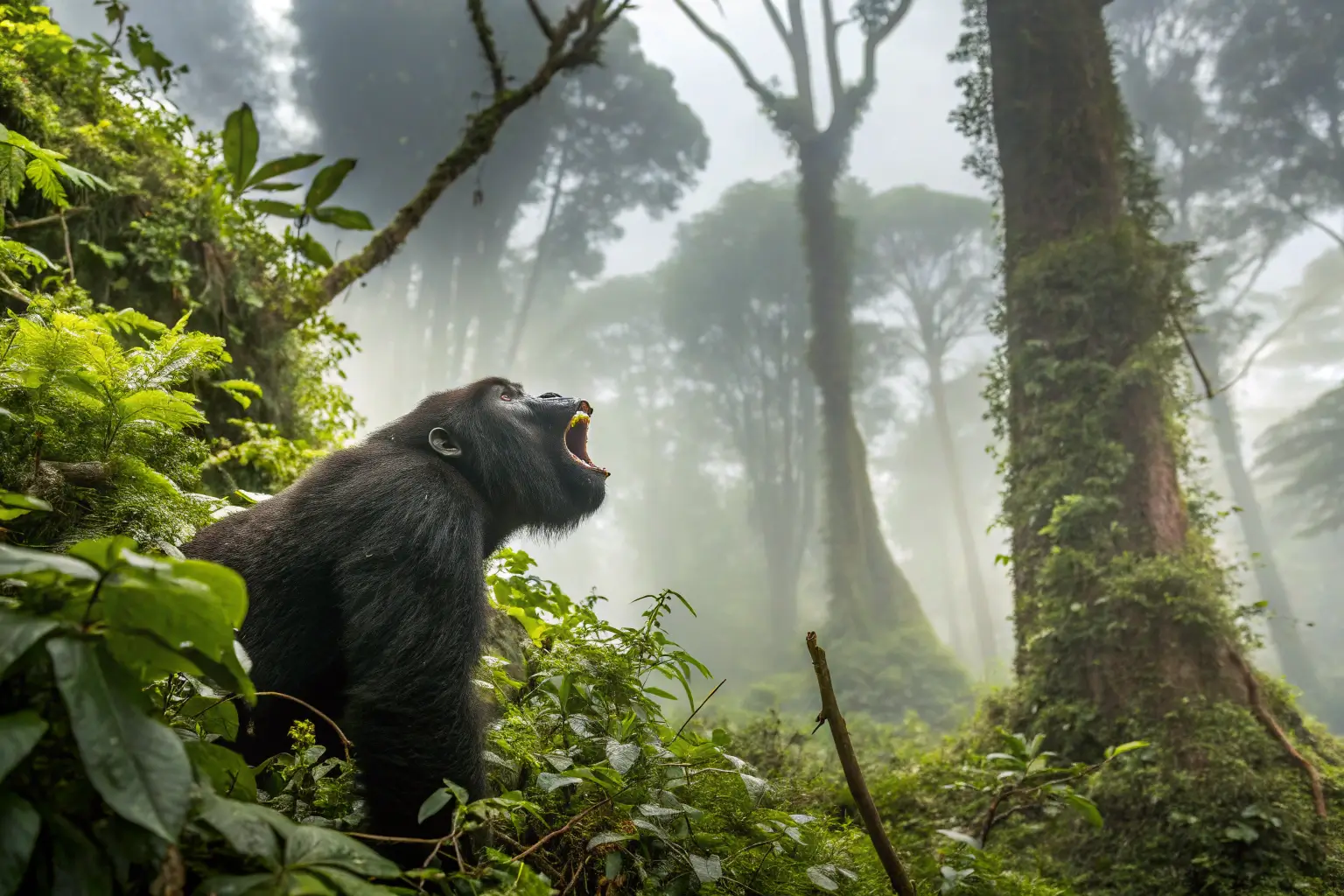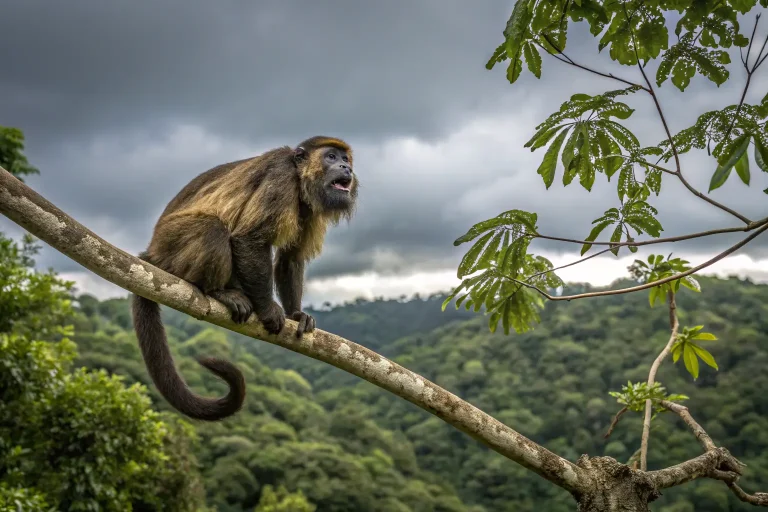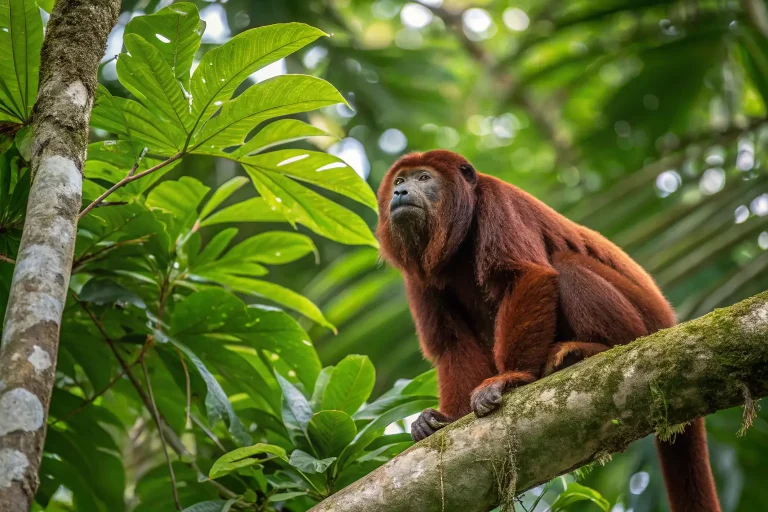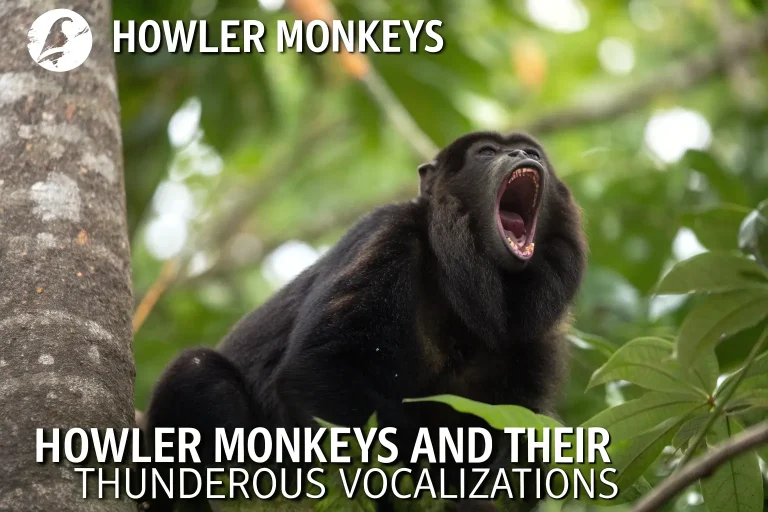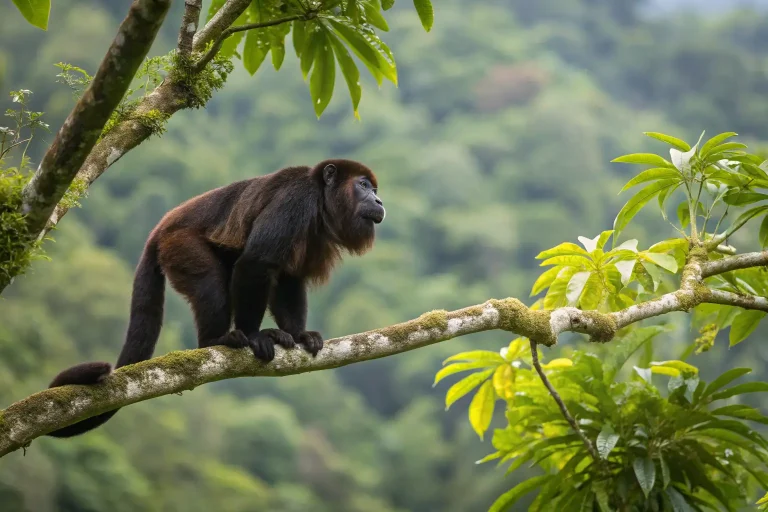How the Sound of Howler Monkeys Can Shock You Awake!
Wake up to the wild with the sound of howler monkeys! Explore the primal scream that turns mornings into a jungle adventure. Learn fascinating animal facts and tips to cope. Discover more now!
Introduction
If you’ve ever been fortunate (or unfortunate, depending on your perspective) enough to camp in the Central or South American rainforests, you’ve likely experienced nature’s most dramatic alarm clock. The sound of howler monkeys echoing through the jungle canopy is an experience that transforms your understanding of what “loud” truly means. These remarkable primates produce vocalizations that can travel up to three miles through dense forest and reach an ear-splitting 140 decibels – louder than a rock concert or jet engine at close range!
The distinctive sound of howler monkeys isn’t just fascinating from a biological standpoint; it represents one of nature’s most impressive adaptations for communication. Understanding these vocal giants offers us insights into primate evolution, rainforest ecosystems, and the increasingly fragile balance between human development and wildlife conservation.
Did you know that despite their earth-shaking roars, howler monkeys are actually among the least aggressive primates? Their intimidating sound serves primarily as a non-violent way to establish territory and communicate with distant group members – quite literally letting their voices do the heavy lifting!
Species Overview
Scientific Name: The howler monkeys belong to the genus Alocatta in the family Atelidae. There are currently recognized 15 species, including the well-known mantled howler (Alouatta palliata) and the red howler (Alouatta seniculus).
Physical Characteristics: Howler monkeys are among the largest New World monkeys, with males weighing between 15-22 pounds (7-10 kg) and females slightly smaller. Their most distinctive physical feature is an enlarged hyoid bone in their throat – essentially a sound-amplifying chamber that enables their extraordinary vocalizations. The sound of howler monkeys is produced when air pushed through this specially adapted vocal apparatus creates resonating effects similar to those of a drum.
Their fur color varies by species, ranging from black and brown to reddish-gold. All howlers possess strong prehensile tails that function as a fifth limb, allowing them to hang from branches while feeding. Despite their intimidating sound, howler monkeys have a relatively small head compared to their body size, with a distinctly beard-like appearance in many species.
Subspecies: Several howler monkey species have recognized subspecies that vary by geographic region. For example, the mantled howler monkey has four subspecies distributed across different parts of Central America, each adapted to slightly different environmental conditions. Each subspecies may produce subtle variations in their iconic howling sound.
Habitat and Distribution
Natural Habitat: Howler monkeys are arboreal creatures, meaning they spend almost their entire lives in trees. They inhabit various types of forests, including lowland rainforests, montane forests, and even some drier forest regions. Their preferred habitat includes tall, mature trees with connected canopies that allow them to travel without descending to the ground.
The lush canopies where the sound of howler monkeys originates provide them with both food sources and protection from ground predators. Their habitat requirements typically include a diverse array of fruiting trees, as fruits constitute a significant portion of their diet.
Geographic Range: Howler monkeys are found exclusively in the Americas, with a range extending from southern Mexico through Central America and into parts of South America, including Brazil, Bolivia, Paraguay, and northern Argentina. Different species occupy different regions within this broad range, with little overlap between species.
Adaptations: Besides their remarkable vocal adaptations, howler monkeys have evolved several other traits that help them thrive in their forest habitats. Their prehensile tails allow them to navigate through the canopy with minimal energy expenditure. Their digestive systems have adapted to process leaves, which constitute a significant portion of their diet when fruit is scarce.
Perhaps most impressively, the sound of howler monkeys serves as a territorial adaptation that allows groups to maintain spacing without direct confrontation. When one group hears another’s calls, they typically move in the opposite direction, efficiently partitioning forest resources through vocal rather than physical competition.
Diet and Feeding Habits
What They Eat: Howler monkeys are primarily folivores (leaf-eaters), which is unusual among primates. Leaves make up approximately 70% of their diet, though they also consume fruits, flowers, nuts, and occasionally small amounts of insects. This leaf-heavy diet is relatively low in nutrients, which explains their generally slow metabolism and energy-conserving lifestyle.
Foraging Behavior: Unlike more active primates, howlers minimize energy expenditure while feeding. They typically feed for a few hours in the morning, rest during the midday heat, and may feed again briefly in the late afternoon. The sound of howler monkeys is often most prominent during their active morning periods, serving as both a feeding coordination signal within groups and a territorial announcement to neighboring groups.
Researchers have observed that howlers prefer young leaves, which contain fewer toxic compounds and are easier to digest. They’re selective feeders, often consuming small amounts from many different tree species rather than concentrating on a single food source.
Dietary Needs: The specialized diet of howler monkeys requires specific adaptations. They have enlarged salivary glands that help break down leaf compounds and specialized molars for grinding tough plant material. Their large intestines contain bacteria that ferment cellulose, allowing them to extract more nutrients from fibrous foods than most other primates can. This dietary adaptation makes them important seed dispersers in forest ecosystems.
Behavior and Social Structure
Social Behavior: Howler monkeys typically live in groups of 10-20 individuals, though group size varies by species and habitat quality. These groups usually contain multiple adult males and females, along with their offspring. The social dynamics are relatively peaceful compared to many primate species, with males showing less aggressive competition than observed in species like baboons or chimpanzees.
Communication: While the sound of howler monkeys is their most famous communication method, they employ a range of other signals. Facial expressions, body postures, and subtle vocalizations help coordinate group activities and maintain social bonds. Their iconic howls serve multiple purposes:
- Territorial defense: The morning chorus establishes group presence
- Group coordination: Howls help scattered group members locate each other
- Male competition: Males may howl to assert dominance without physical confrontation
- Environmental response: Groups often howl in response to thunderstorms or other loud disturbances
The morning chorus typically begins just before dawn and can last for 30-60 minutes. The sound builds gradually, with males initiating and females sometimes joining in with their own, slightly higher-pitched calls.
Mating and Reproduction: Female howlers reach sexual maturity around 3-4 years of age, while males mature between 4-5 years. They don’t have a specific breeding season, though births may cluster during times of abundant food resources. The gestation period lasts about 6 months, typically resulting in a single offspring.
Infants cling to their mothers’ abdomens for the first few weeks of life before gradually becoming more independent. Mothers provide most parental care, though other females in the group may occasionally assist. Interestingly, the sound of howler monkeys is rarely produced around newborns, possibly to avoid drawing predator attention to vulnerable infants.
Conservation Status
Endangerment Level: Conservation status varies significantly among howler monkey species. According to the IUCN Red List, some species like the black howler monkey (Alouatta caraya) are listed as Least Concern, while others like the Maranhão red-handed howler (Alouatta ululata) are Critically Endangered. Most species face population declines.
Threats: The primary threats to howler monkey populations include:
- Habitat loss due to deforestation for agriculture, cattle ranching, and urban development
- Fragmentation of forests, which isolates populations and reduces genetic diversity
- Hunting for bushmeat in some regions
- Capture for the illegal pet trade
- Disease outbreaks, including yellow fever, which can devastate howler populations
The sound of howler monkeys, once common throughout vast stretches of Latin American forests, has gone silent in many regions where these threats have been most severe.
Conservation Efforts: Several conservation initiatives focus on protecting howler monkey habitats and populations:
- Creation and maintenance of protected areas and biological corridors
- Reforestation projects that reconnect fragmented habitats
- Community-based conservation programs that provide alternatives to deforestation
- Research programs monitoring population health and genetic diversity
- Ecotourism initiatives that create economic incentives for preserving forests where visitors can experience the sound of howler monkeys firsthand
Organizations like Proyecto Tití in Colombia and the Wildlife Conservation Society work specifically on howler monkey conservation through these various approaches.
Interesting Facts
World Record Holders: The sound of howler monkeys has earned them a place in the Guinness Book of World Records as the loudest land animal on Earth. Their calls can reach 140 decibels – comparable to a jet engine at takeoff and loud enough to cause pain and hearing damage in humans with prolonged exposure.
Specialized Equipment: To produce their incredible howls, male howlers have a hyoid bone that’s 25 times larger than a human’s, despite having a much smaller overall body size. This bone forms a resonance chamber that amplifies their vocalizations exponentially.
Energy Conservation Champions: Howlers sleep or rest for up to 15 hours per day, making them among the least active primates. This sedentary lifestyle conserves energy needed for their leaf-based diet.
Color-Changing Eyes: Baby howler monkeys are born with blue eyes that gradually change to a golden-brown color as they mature.
Predator Deterrents: Scientists believe the howls may have evolved partly as a way to deter predators like harpy eagles and jaguars by creating the impression of a larger, more formidable animal.
Acoustic Engineering: The sound of howler monkeys travels most effectively in the early morning when temperature inversions in the forest create optimal acoustic conditions for long-distance sound propagation.
Cultural Significance: Howler monkeys figured prominently in Maya mythology, associated with the sun god and featured in various ceramic art pieces from pre-Columbian Mesoamerica.
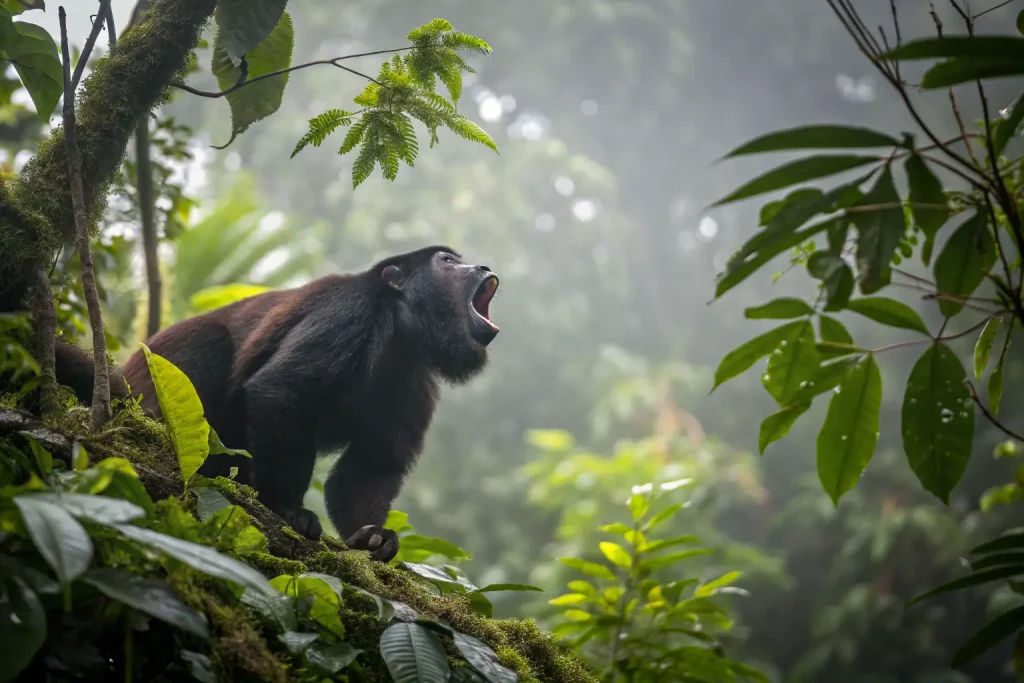
Tips for Experiencing Howler Monkeys
If you’re planning a trip to experience the sound of howler monkeys in their natural habitat:
Best Viewing Locations:
- Tikal National Park in Guatemala
- Corcovado National Park in Costa Rica
- Monkey River in Belize
- Amazon Basin regions of Brazil and Peru
Visitor Guidelines:
- Visit during early morning hours (5:00-7:00 AM) when howling is most active
- Bring binoculars – howlers often remain high in the canopy
- Maintain quiet while observing to avoid disturbing natural behaviors
- Never feed wild howler monkeys as it disrupts natural foraging patterns
- Consider hiring a local guide who knows howler territories and behaviors
Photography Tips:
- Use a telephoto lens (at least 300mm) for good images
- Tripods help with stability in low morning light
- Consider recording equipment for capturing the sound of howler monkeys
- Be patient – good wildlife photography requires waiting for natural behaviors
Role in the Ecosystem
Ecological Importance: Howler monkeys serve as vital seed dispersers throughout tropical forests. By consuming fruits and excreting the seeds intact some distance away, they help maintain forest diversity and regeneration. Their selective leaf consumption also influences forest composition by creating pressure on certain tree species while favoring others.
The sound of howler monkeys also serves as an ecological indicator. As one of the most easily detected rainforest species, their presence or absence helps researchers monitor ecosystem health. Many birds and other mammals also use howler vocalizations as information sources about potential predators or resource locations.
Impact of Decline: If howler populations decline significantly, several ecological consequences might follow:
- Reduced seed dispersal would affect forest regeneration patterns
- Changes in vegetation composition due to altered browsing patterns
- Impacts on predator populations that rely on howlers as prey
- Loss of a keystone species that influences many other forest organisms
Some evidence suggests that forests without howler monkeys show reduced diversity in certain plant families that depend heavily on primate seed dispersal.
Conclusion
The sound of howler monkeys represents one of nature’s most remarkable acoustic adaptations – a biological megaphone that helps these peaceful primates navigate their complex social and ecological landscape without expending the energy that physical confrontation would require. From their specialized anatomical adaptations to their energy-conserving lifestyle, howlers exemplify evolution’s capacity to produce specialized solutions to environmental challenges.
As rainforests continue to face unprecedented threats from human activities, the haunting calls of howler monkeys serve as both a reminder of what we stand to lose and an opportunity to appreciate the extraordinary biodiversity our planet harbors. By supporting conservation efforts in Central and South America and making sustainable choices in our own lives, we can help ensure that future generations will still have the opportunity to be shocked awake by the primordial sound of howler monkeys echoing through intact, thriving forests.
Whether you’re planning a rainforest adventure or simply fascinated by unique wildlife adaptations, howler monkeys offer a window into a world where voice, not physical strength, defines success – a strategy that has served them well for millions of years and continues to inspire awe in all who hear them.
Frequently Asked Questions
How loud is the sound of howler monkeys compared to other animals?
Howler monkeys produce calls that can reach 140 decibels, making them the loudest land animals on Earth. For comparison, a lion’s roar reaches about 114 decibels, and a wolf howl measures around 90 decibels. The howler’s call is comparable to standing near a jet engine or attending a rock concert without ear protection.
Why do howler monkeys make such loud sounds?
The primary purposes of their iconic howls are territorial defense, group coordination, and male competition. By howling, groups can establish and maintain territory boundaries without direct confrontation, which conserves energy and reduces injury risk. The sound of howler monkeys also helps scattered group members locate each other in dense forest environments.
What time of day are howler monkeys most vocal?
Howler monkeys are most vocal at dawn, typically beginning their chorus about 30 minutes before sunrise. This timing coincides with optimal acoustic conditions in the forest, when temperature inversions create sound channels that allow their calls to travel farther. They may also howl during weather changes or when disturbed by predators or other environmental factors.
Can howler monkeys be kept as pets?
No, howler monkeys should never be kept as pets. Beyond being illegal in most countries, they have specialized dietary needs, complex social requirements, and can live 15-20 years. The sound of howler monkeys alone makes them unsuitable for domestic settings, as their calls would disturb entire neighborhoods. Additionally, the pet trade threatens wild populations and contributes to conservation challenges.
How can I tell different howler monkey species apart?
Different howler species can be distinguished primarily by fur color and geographic location. For example, mantled howlers have black bodies with golden mantles, red howlers are uniformly reddish-brown, and black howlers are entirely black (males) or blonde (females). Each species also has subtle differences in the sound of their howls, with trained researchers able to identify species by vocalization patterns.
Are howler monkeys endangered?
Conservation status varies by species. Some howler species are classified as Least Concern, while others are Vulnerable, Endangered, or Critically Endangered according to the IUCN Red List. All species face threats from habitat loss, and several have experienced significant population declines in recent decades.
What should I do if I’m camping and get woken up by howler monkeys?
If you’re awakened by the sound of howler monkeys while camping, consider yourself fortunate to experience one of nature’s most impressive displays! Use the opportunity to observe them with binoculars as they’re likely to be active after howling. Earplugs can help if you want to return to sleep, though most visitors find the experience memorable enough to forgive the early wake-up call.

